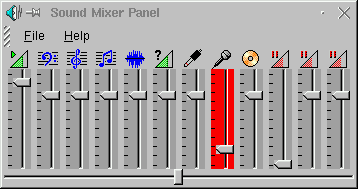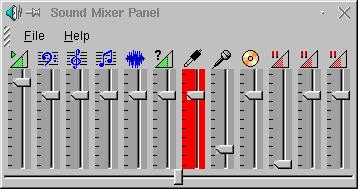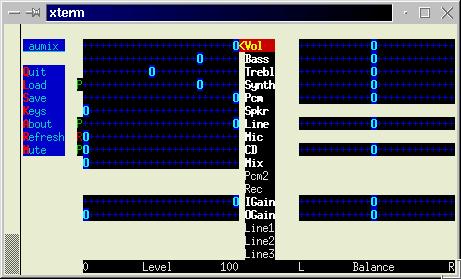
Figure 1: The standard KDE mixer-settings.
![[Photo of the Author]](../../common/images/PhilipGroot.jpg)
original in nl Philip de Groot
nl to en Philip de Groot
Soon, he will get his Ph.D. at the University of Nijmegen on the subject of chemometrics. He enjoys working with Linux and writes down his experiences on a regular basis.
![[Illustration]](../../common/images/article178/image_art178.jpg)
IntroductionUsually, it is impossible to directly convert wave-sound to mp3-sound in real-time. The procedure that one should follow is:
Recording a wave-file quickly takes up quite a lot of disk space (100 MB for 10 minutes of stereo music in CD-quality). This restricts the storage capacity for music recorded in this format. An mp3-encoder is capable of converting the wave-file of 100 MB to 10 MB in the standard mp3-quality (128 kbps, stereo). This property enables the digital recording of music for 24 hours, without any interruption! 24 hours is 60*24 = 1440 minutes, using only 1,4 GB (1440 MB) hard disk space!!! I have used this feature to record the eighties top 300, transmitted by Loostad radio (some English pages are also available). The recording was interrupted just once, the mp3-recording program stops automatically after 24 hours and this was not documentated..., the recording was very good! I will show you what software I used and explain alternative ways to make real-time mp3-recordings. I have as well made the software used for this article available on seperate page (links are further down in the article). |
'Mpegrec' does the same as 'sox | lame', but different settings are already defined. The user does not need anything else. Just installl 'Lame'! I advise you to use 'mpegrec'. However, keep in mind that this program stops after 24 hours!!! Furthermore, an annoying casting-bug results in erroneous recording times: the recording time as set by the user is not correctly used. Most of the times, it is quite a lot shorter!
| -b | Use 128 kbps as the mp3 bitrate. The standard value in 'mpegrec' is 192, which is a strange (and much too high) value. Almost all mp3-files have a constant bitrate of 128 kbps. |
| -o | Name of the output file. In this example: ./test.mp3. If no output file is defined, everything is sent to the standard output ('stdout'). Usually, this is the xterm in which the program is executed. All mp3-codes are plotted on your screen instead of being stored in a file... |
Attention:
Please take care that your mixer-settings are set
correctly. If not, nothing will be recorded! The correct
recording-source should be selected and the appropiate volume-controls
should be at their highest settings.
| sox | The recording program: sound is recorded using the 'line-in' of the soundcard. |
| -t ossdsp | The sound input originates from the OSS sound drivers. These drivers are included with the Linux kernel if the standard sound support is included. |
| -w | Sample bit type is 16 bit long word (if you do not understand this: don't bother, it is not important). |
| -s | The 'sample data' is 'signed linear' (if you do not understand this: don't bother, it is not important). |
| -r 44100 | The sampling frequency is 44100 Hz (CD-quality). |
| -c 2 | Record from 2 channels (stereo). |
| /dev/dsp | This is the sound-sampling device: the Linux-device that delivers the recording data. All devices, ports, disks, and so on are accessed using the '/dev'-directory. The wave-stream is accessed in linux from '/dev/dsp'. As a matter of fact, it is even possible to get your soundfile using the following command: 'cat /dev/dsp >test.wav' (works only if the mixer-settings are correct!!!). |
| -t raw | The output is 'raw' data (unchanged, straight from the soundcard). |
| - | Use the standard output, symbolised by '-' |
| lame | The encoder program: the recorded sound is piped to 'lame' for the mp3 conversion. |
| -x | 'Force byte-swapping of input'. I do not know the precise function of this option, but without it the procedure simply does not work (before I found this out!). |
| -m s | Encode as stereo mp3-file. Standard, 'lame' encodes it as 'joint-stereo': only the DIFFERENCES between both sound channels are encoded. As a result, a higher compression is obtained, but the mp3-quality is poorer. |
| - | Input is 'stdin'. This is correct for the current example. |
| ./test.mp3 | The name of the final mp3-file. |

Figure 1 depicts that the microfone is the current recording-source.
For our purpose, an external source is connected to the computer using
the 'line-in' connector on the soundcard. The recording-source should
be the 'line-in'. If the mouse-pointer is positioned on the line-in
channel of the KDE-mixer, a right-click results in the menu that is
depicted in Figure 2:

Off course, 'RecSource' is selected to set the 'line-in' of the soundcard as the recording-source. Use the same procedure to turn the microfone off as a recording-source: you do not want to have the additional noise!

Figure 3: The KDE-mixer is set correctly.
The remarks above indicate that recordings can be obtained best if
no graphical environment is present. This means that the Bash-shell
should so used (a text-based shell). This approach has some
consequences:
These two problems can be solved quite easily. The first problem,
sound support, is solved as follows:
'modprobe -k sb'
This command loads the module 'sb', which installs my soundcard (a SoundBlaster AWE 64). If you do not know which module should be installed, please look in your '/etc/conf.modules' (SuSE) or '/etc/modules.conf' (depending on your distribution). For me, the soundcard part is the following:
The second problem is selecting the 'line-in' on your soundcard with a
text-based mixer-program. I use the 'aumix' program. If in Bash the
command 'aumix' is executed, the mixer starts in interactive mode. In
this mode, settings can be checked and changed in a glance, see Figure
4.

You can select the different recording sources with the arrow buttons. The '<' or '>' buttons selects the volume (left) or the balance (right). The '+' and '-' buttons increases and decreases the volume of the currently selected source. 'm' mutes or unmutes the current source. If the current source is selected as recording source, a red 'R' is displayed on the left of this volume source. If the source only can be used for playback, a green 'P' is displayed. Pressing 's' saves the current settings in '~/.aumixrc'. These settings are activated very easily on the next startup with the command: 'aumix -l'.
To automate the above procedure, I have written a small script:
'./mrec test.mp3'. This script contains the following lines:
#!/bin/sh if [ -z "$1" ]; then echo "Usage: mrec mp3-output-file" exit 0 fi modprobe -k sb aumix -l mpegrec -b 128 -o "$1"
The 'lame'-files and installation tips can be found here.
The lines that do not have a '#' should get one now. You do not need these extra options!
mv /usr/sbin/cron /usr/sbin/cron.backup
It is likely that the location of 'cron' differs for other Linux distributions. You can find the location of 'cron' with the following command:
which cron
Please check whether 'cron' is needed for other tasks! On a desktop Linux machine, this should not be a problem.